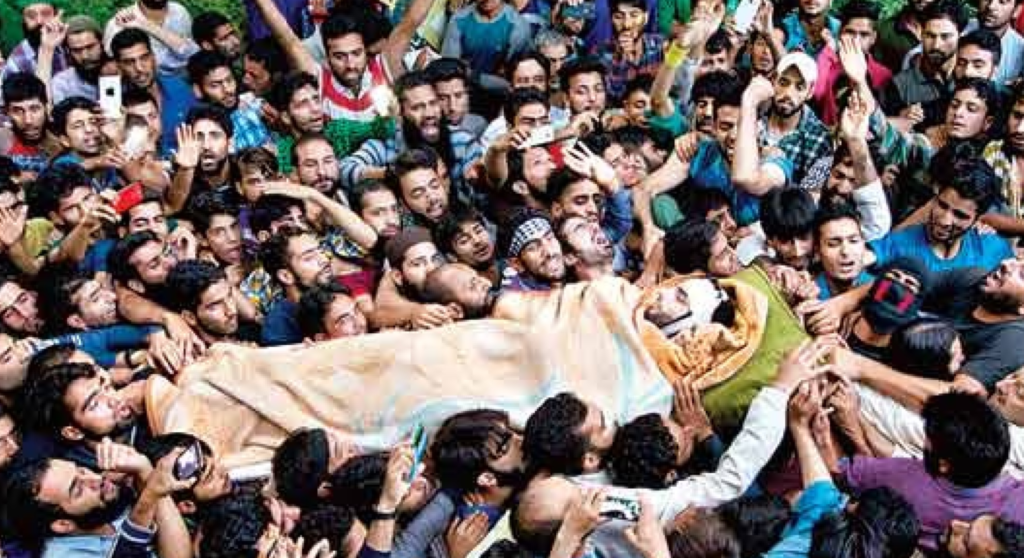
The Emergence of Burhan Muzafar Wani as a Symbol of Resistance in Kashmir
Gowhar Farooq
In the early hours of dawn, the crackle of gunfire pierced the serene valley. Trapped in a cordon with his two associates, Aijaz Ahmad Bhat of Lurgam, Tral, lay wounded and defiant. As bullets whizzed past, he made a desperate last wish: “Tell Aarif Khan to pray for my forgiveness.” But amidst the deafening chaos, the name Aarif Khan was lost. Aijaz shouted again, “Tell Burhan to pray for my forgiveness.”
Burhan Muzaffar Wani—a name that, until that moment, had been known to few outside his small circle. Aijaz’s final plea, caught on a phone call, quickly spread through the valley thereby marking the birth of Burhan’s legend. By the end of that firefight, Aijaz and his associates, Shabir Ahmad Bhat and Shahnawaz Ahmad Mir were martyred but Burhan’s name was deeply inscribed into the collective consciousness of Kashmir.
Burhan Muzaffar Wani, the teenage son of a school principal, was no ordinary fighter. His charisma and innovative use of social media transformed him from a mere foot soldier to the face of a new age armed resistance in Kashmir. In August 2013, a profile in The Guardian highlighted his novel approach to shed light on South Asia’s most protracted dispute and propelled his image as a fighter for its resolution onto the international stage. With his boyish looks and tactical acumen, the young commander captivated the youth, who saw in him a hero fighting for a cause larger than life.
Before his rise to prominence, Burhan had seamlessly blended into the local population and evaded capture with an almost uncanny ease. His teenage visage masked the growing resolve and strategic mind that would soon redefine the armed resistance in the region. Up until mid-2013, media references to him were scarce and often erroneous. A premature report of his death only served to fuel the mystique surrounding him.
His true strength, however, lay not just in his strategic mind but in his character. “His strength was his character and his utmost cautiousness to not kill an innocent person,” said Muhammad, a close companion, to a prominent journalist of the valley. The journalist was later arrested and put behind the bars for more than five years for writing a newspaper article on the rise of Burhan, insights from which are reflected in this write-up. He was recently released on bail for a short time and rearrested hours after reaching home. Burhan’s adherence to a moral code, even in the heat of battle, earned him respect from friends and foes alike.
The journey to becoming a revered commander was fraught with hardship. After Adil Mir’s death in a 2014 encounter, Burhan took the reins of Hizbul Mujahideen. His leadership style was inclusive, with a network of associates and well-wishers who managed logistics, communications, and recruitment. This decentralized model ensured resilience and continuity, even under intense military pressure.
Burhan’s ingenuity in using social media became his signature strategy. His images and messages went viral and created a groundswell of support. He did not merely command an armed resistance group; he commanded a narrative, one that resonated deeply with the disenfranchised youth of the occupied region.
The Indian military and police, recognizing the growing threat, launched a smear campaign to tarnish his image. Propaganda portrayed Burhan as a mole and alleged collusion with the state. These efforts by the occupational apparatuses, however, only strengthened his resolve and bolstered his support base. The martyrdom of his brother, Khalid Muzaffar Wani under interrogation by the Indian occupational army in 2015, dispelled many of these rumors and reaffirmed Burhan’s commitment to the noble cause of Kashmir’s war of liberation.
Despite a huge crackdown to track him down by Indian military and paramilitary forces, Burhan not only continued to remain untraced but strengthened his organization in many ways. His actions inspired a new generation of resistance fighters. His strategic acumen and ability to read the battlefield allowed him to break through cordons that would have ensnared others.
The turning point came with Burhan’s martyrdom in July 2016. His martyrdom ignited a wave of protests across the valley, as thousands took to the streets, throwing stones and clashing with Indian occupational forces. The armed resistance he had revived and redefined reached a fever pitch and drew the attention of international bodies like the United Nations.
Smear Campaign
After Burhan shot to fame and became a symbol of resistance in the region, the police and military initiated a smear campaign to delegitimize his cause and portray him as a double agent primarily working for the Research and Analysis Wing (RAW), the top intelligence agency of the Indian state. It was 2014, and I was playing cricket in a local playground in southern Kashmir when a friend sitting nearby showed me a picture of Burhan wielding multiple automatic rifles with the caption “Mukhbir” on it. He had received it through a WhatsApp group run by a local policeman with close links to the Superintendent of Police, Pulwama. There were more pictures of Burhan with similar captions. These pictures and fabricated stories about how he collaborated with the military and police, got his companions killed, and fled the cordon were spread across the valley, causing people to grow suspicious and disillusioned. A few days after this incident, I heard people discussing these rumors in hushed tones. Confusion had gripped the people in the valley as the smear campaign became more intense and dirty. This was perhaps the first time the occupational apparatuses systematically used social media to discredit a Kashmiri resistance commander.
After achieving the desired results, the propaganda campaign aimed at character assassinating resistance fighters and tarnishing the image of armed resistance intensified. Police and military-run IT cells released fake audio clips of fighters making objectionable statements and, at times, even accusing commanders in the base camps of treason. This practice continues to this day. Following the martyrdom of Burhan Wani, Indian national television news channels began to defame him in their prime time shows, portraying him as a womanizer with multiple girlfriends. They sensationalized the narrative by broadcasting completely fake news under the guise of ground reports, aiming to defame and delegitimize the entire Kashmiri freedom movement. However, Kashmiris knew it was all false and dirty propaganda orchestrated by Indian intelligence agencies.
Before this, these rogue intelligence agencies had run smear campaigns against Syed Ali Shah Geelani and his associates. The Qaide-e-Inqilaab and prominent figures from Kashmir’s political resistance leadership were falsely accused of involvement in money laundering and other wrongful activities. This was a blatant lie intended to defame those who had sacrificed everything in the liberation struggle and spent decades in various jails across Kashmir and India. India has consistently used these underhanded tactics to discredit the Kashmiri freedom struggle and sow seeds of hatred against their leadership among the Kashmiri people. The police have always played a significant role in these campaigns. Before the advent of the internet, the police and intelligence agencies used to paste posters across Kashmir depicting Kashmiri resistance leaders as corrupt, double agents, and more. This propaganda has now escalated to a new level, with the Indian film industry, Bollywood, releasing propaganda movies on Kashmir. This trend has accelerated post-2019, with Bollywood producing several such movies. A recently released movie titled “Article 370” starts with a story of Burhan and a military operation in which he is killed. Based on vile propaganda, the movie portrays Burhan as having illegal relationships with multiple women. The movie further depicts the political leadership of the Kashmir resistance as corrupt and portrays protests against Indian occupation as “instigated.”
Propaganda has always been a powerful tool used by colonizers and occupiers to undermine and discredit resistance movements. By spreading false information, fabricating stories, and manipulating public perception, they aim to weaken the morale of the resistance and erode the support it receives from the local population and the international community. These tactics involve character assassination of key resistance figures, portraying them as morally corrupt or double agents, and depicting the resistance movement as illegitimate and driven by ulterior motives. Historical examples abound where occupiers have employed propaganda to maintain control and justify their actions. In the case of Kashmir, India’s use of media, including social media and Bollywood, to run smear campaigns against resistance leaders and the broader freedom movement is a clear continuation of this age-old strategy. Such efforts are designed to create confusion, mistrust, and division among the people, thereby weakening the resistance and prolonging the occupation. Despite these attempts, the truth about the aspirations and struggles of the oppressed eventually emerges, as the resilience and determination of those fighting for their freedom cannot be permanently obscured by propaganda. Shaheed Burhan and others who have sacrificed their lives to see their homeland free from the shackles of slavery will forever remain as heroes of Kashmir’s war of liberation and the Kashmiri nation will continue to hold these great commanders and leaders in reverence no matter how hard the rogue Indian intelligence agencies along with police and military try to run smear campaigns and defame them.



